Projects
I consider projects to be reasonably large works that involve lots of different components and a few weeks or months of concentrated effort and willpower to complete. Small toy programs that only take a day or two would be mentioned in my blog, but not here.
siliconnn (2023) [link]
I had been wanting to build a project in assembly for a while (ever since essentially late middle school); there was just something so appealing about the idea of laboring away with such a primitive, raw medium, building up each piece of functionality from nothing, and putting it all together into a polished, sophisticated machine.
I finally got the chance to do so with siliconnn, which is a full neural network implementation in ARM64 assembly – no dependencies, no calling C functions. It includes a long list of features, but the main highlights include:
- Loading datasets from CSV, normalizing features, and shuffling
- Splitting datasets into training and testing sets
- Initializing fully-connected, feedforward neural networks with configurable numbers of input and hidden neurons
- Training NNs with configurable learning rate and number of epochs
- Computing and printing mean squared error over a dataset
- Dumping trained networks to files / loading pretrained networks from files.
 A network created with siliconnn for classifying the Iris dataset.
A network created with siliconnn for classifying the Iris dataset.
Continuing with the artisanal analogy from earlier, most of the insight in this project occurred while writing the C reference implementation for it, akin to producing a pencil sketch before beginning the actual piece. Beyond that, the work translating into Assembly was pretty quiet and modest, while being one of the bigger tests I’ve faced in terms of endurance.
I do feel that I learned a lot, and gained a lot more solid understanding of C and lower-level programming by working with Assembly. And I think I’ve gotten my fill of Assembly writing for this lifetime.
ptree.ml (2022) [link]
ptree.ml (short for Property Tree) is a “universal adaptor” between the extraordinarily popular data serialization formats INI, JSON, and XML for OCaml. It provides support for parsing any of these formats into a unified data structure, making edits / adding new data, and then exporting data back out to any of those file formats.
As such, it can be used as
- a single, familiar tool to parse multiple file formats (no need to learn a new API every time);
- a tool to convert between different file formats (e.g. read in an INI file, write it out as JSON);
- a way to easily serialize any data you have (not just modifying pre-existing data from another file – you can easily build up your own tree from scratch and write it to whatever format you like).
The API exposed for editing property trees views these trees as a file system,
where categories of properties are directories and the properties are the files
themselves. Fittingly, the API closely resembles filesystem operations in the
Unix terminal, with functions such as cd, ls, cp, cat, rm, and more.
Everything is built from scratch using only the standard library, including the parsing. Parsing is accomplished through a homemade parser combinator libary. The property editor is modeled after the Zipper data structure, and allows edits to happen on property trees in a fast, immutable, persistent, and memory-efficient manner.
neche (2021) [link]
This project evolved small neural networks to play checkers. Networks were given 32 “sensory neurons” – to look at the different individual squares on the board – as well as some inner neurons. They output a single evaluation score, which a minimax algorithm (with alpha-beta pruning) used to explore future variations.
A “population” of several hundred networks would play a tournament-ish format against itself each generation; the more successful networks that won more games were more likely to become parents to the offspring in the next generation of the population.
Network structure was encoded in a genome, where each 16-base pair gene encoded a single synapse from one neuron to another. To create offspring, crossing-over was simulated between the two parent genomes, and translocation and point mutations were induced.
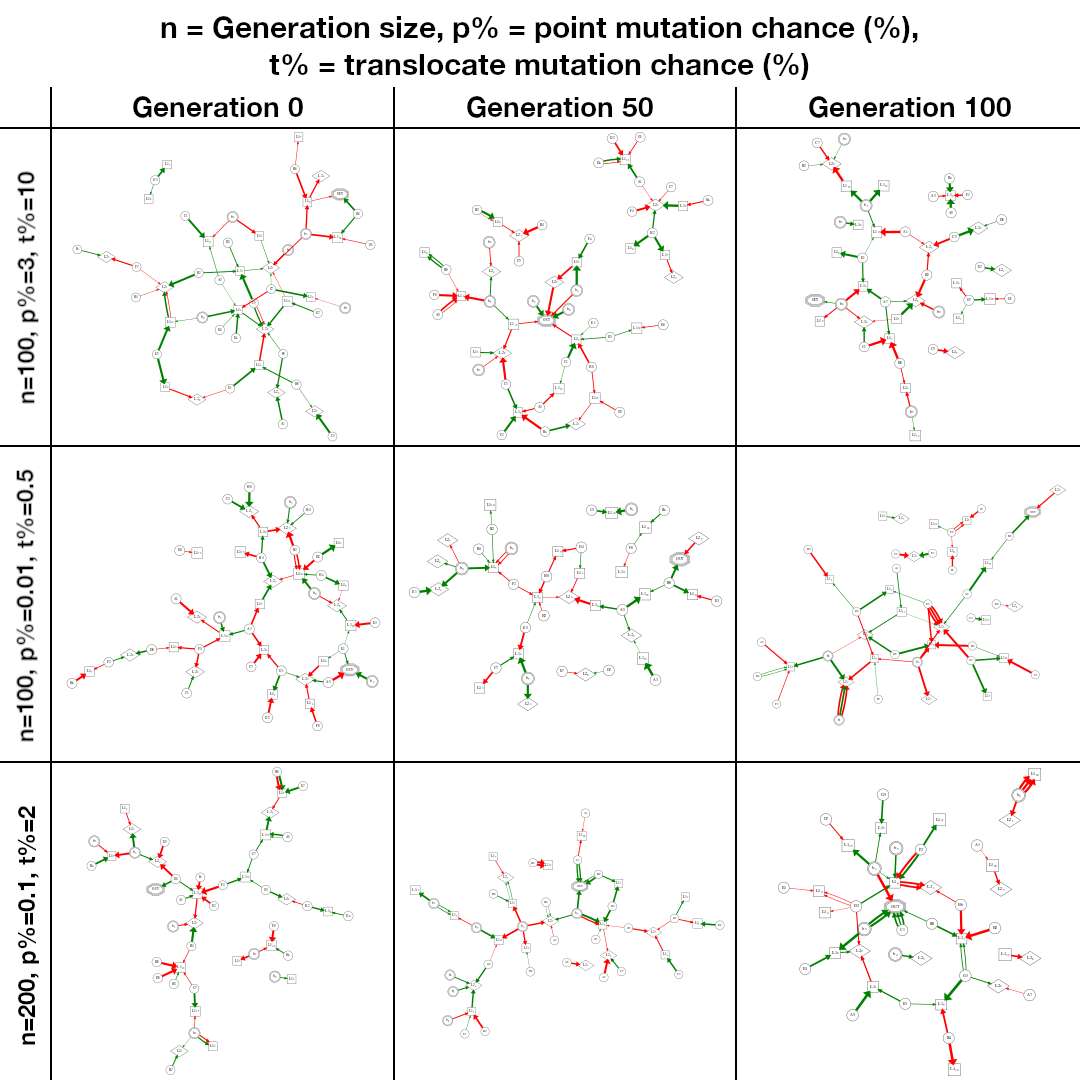 A variety of different networks generated by evolution with different
parameters
A variety of different networks generated by evolution with different
parameters
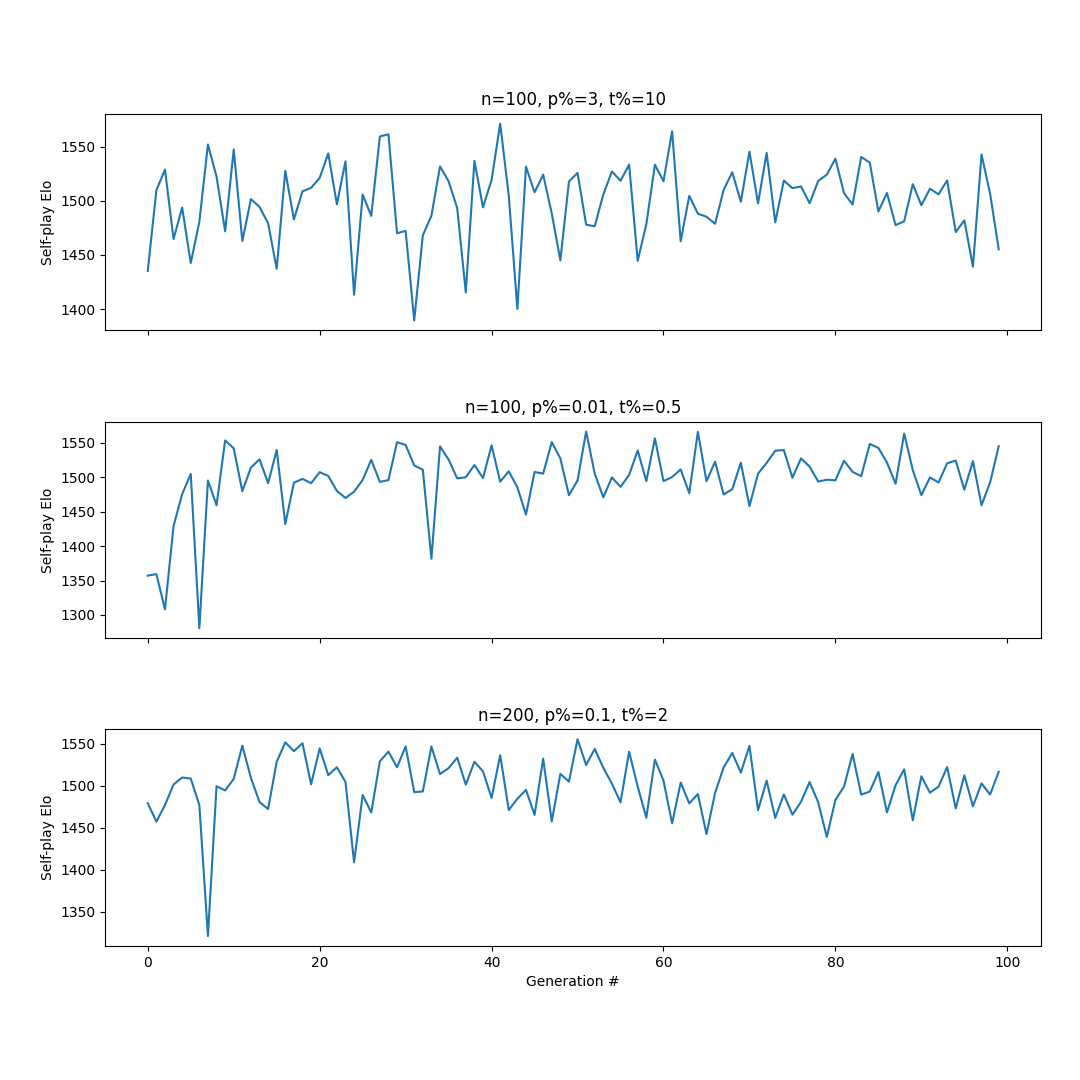 The networks’ self-play Elo over generations. On my laptop, it was unable to
escape the plateau after a quick initial jump. Higher mutation rates meant more
volatile Elo from generation to generation.
The networks’ self-play Elo over generations. On my laptop, it was unable to
escape the plateau after a quick initial jump. Higher mutation rates meant more
volatile Elo from generation to generation.
This project was built using Rust, as well as the rayon crate to run each
generational tournament in parallel. All evolution, tree search, and move
move generation features were implemented from scratch.
CHS Math Bowl (2020) [link]
Developed for Collierville High School’s annual Math Bowl, it featured scoreboard and timers for each competition room, as well as an admin console that controlled starting & stopping rounds, handling disputes, etc. In the auditorium, a unified scoreboard and leaderboard showed the standings of all teams, and live-updating scores as the rounds progressed.
The admin console on the laptop screen, and the auditorium scoreboard displayed on the projector in the background.
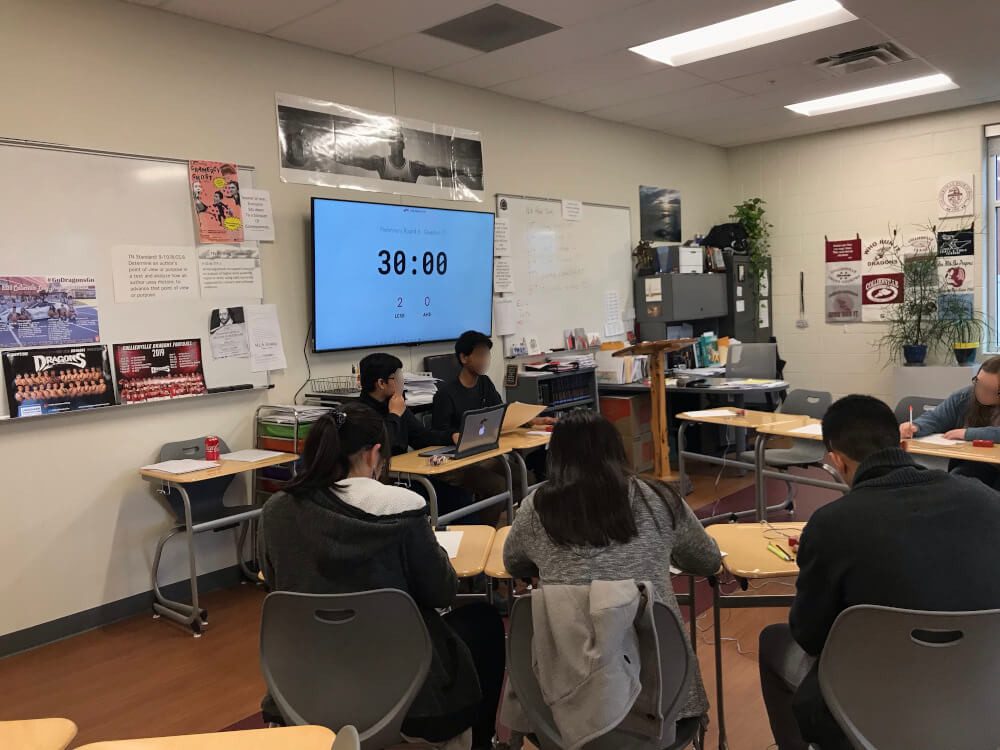 The scoreboard and timer for one of the individual rooms, during a preliminary
round.
The scoreboard and timer for one of the individual rooms, during a preliminary
round.
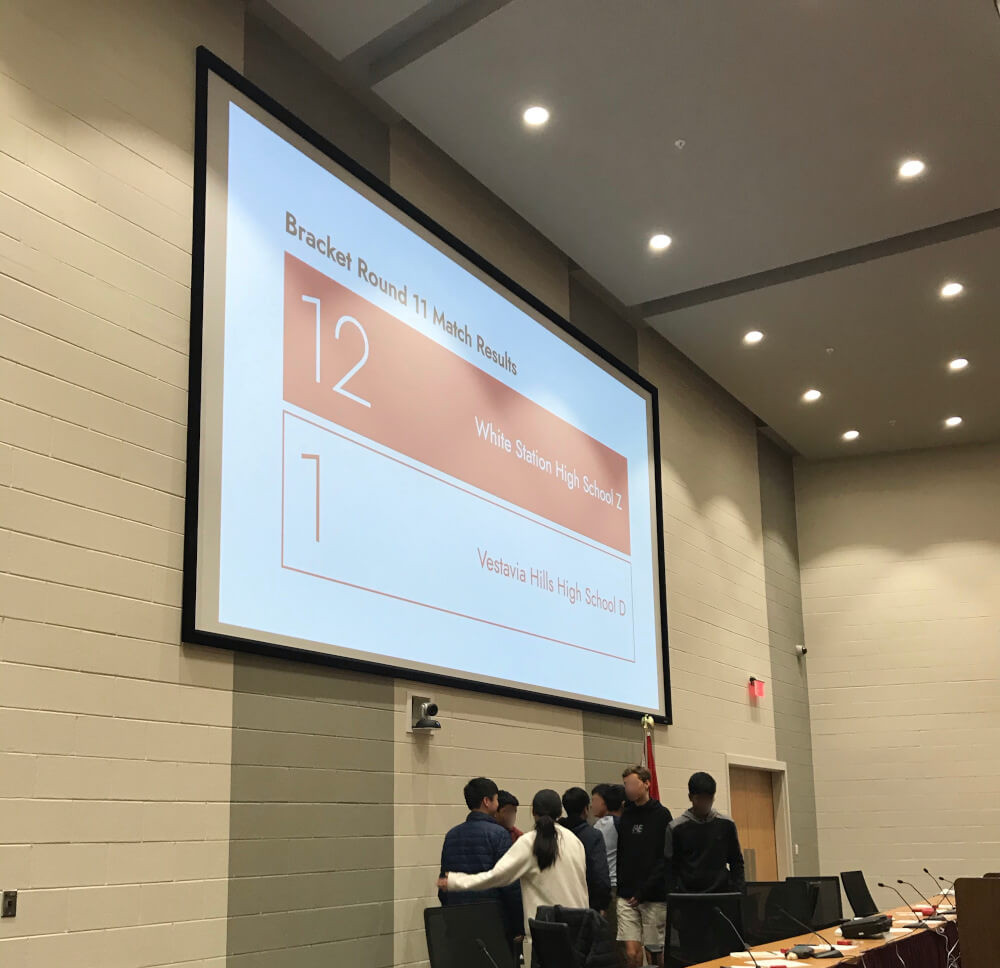 The final score displayed during a semifinal round in the main auditorium.
The final score displayed during a semifinal round in the main auditorium.
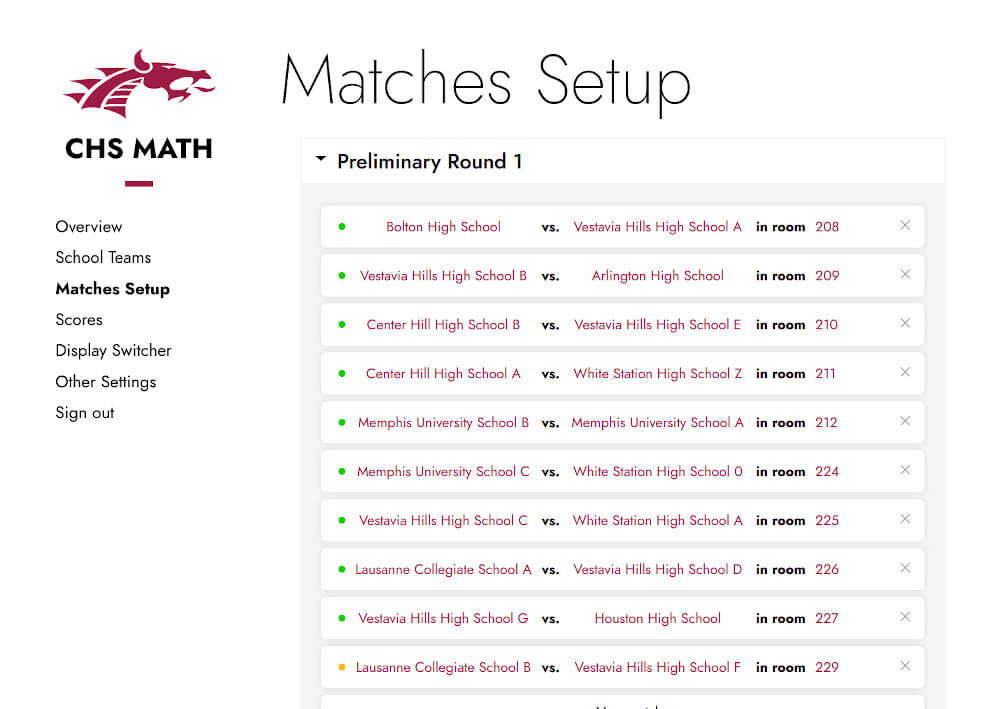 A closer look at the admin console, here queuing up matches from the bracket
for each of the individual rooms. A green dot meant the room had completed the
round; yellow meant the round was still in progress.
A closer look at the admin console, here queuing up matches from the bracket
for each of the individual rooms. A green dot meant the room had completed the
round; yellow meant the round was still in progress.
This project was developed completely from scratch in HTML, CSS, and JavaScript using Google Firebase. In hindsight, probably React should’ve been used, as the code is quite rushed and messy. But it worked great, almost flawlessly for the entirety of the tournament. There was a slight bug where a score somehow was submitted twice, but it was trivial to remove it in the admin console.
About |
Blog |
Projects |
Links
© 2024 Brandon Gong.
RSS feed.